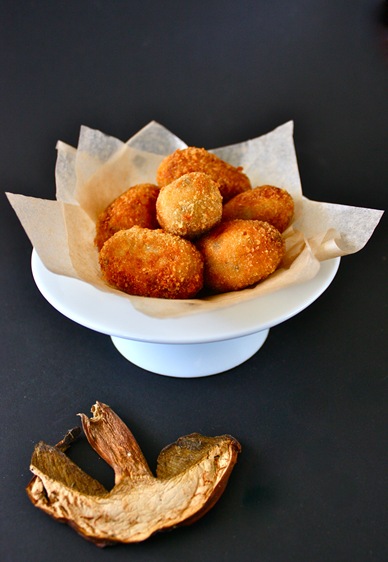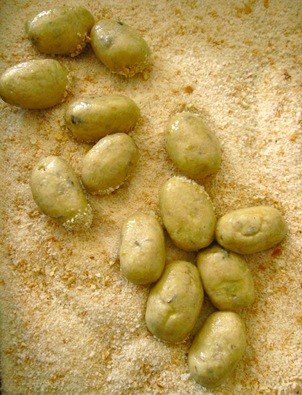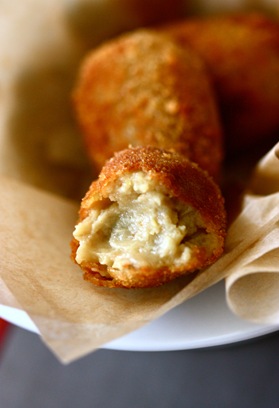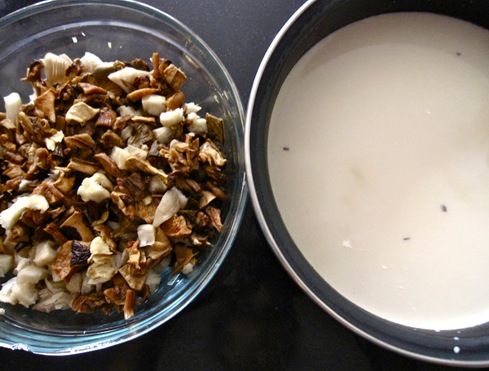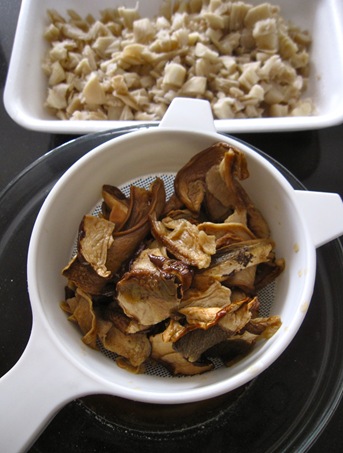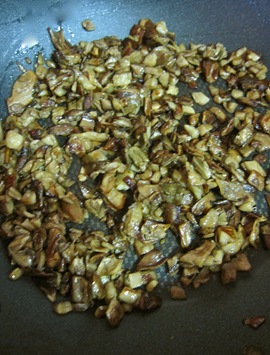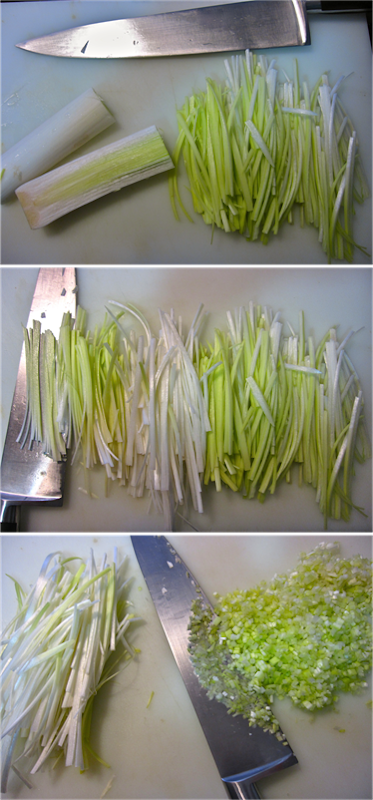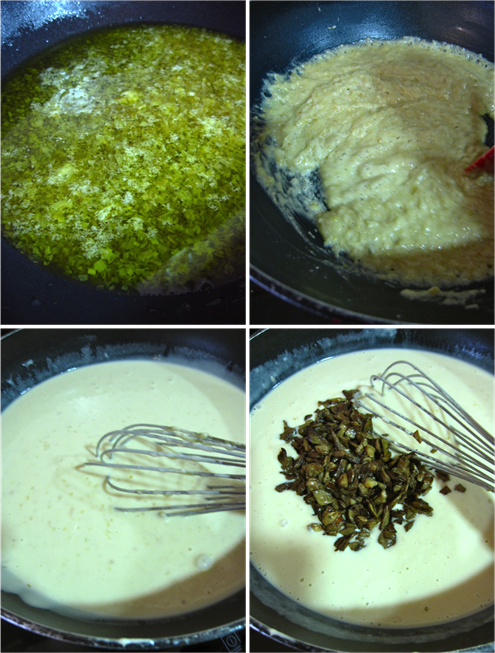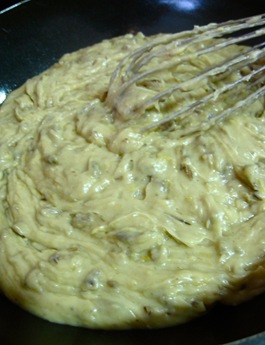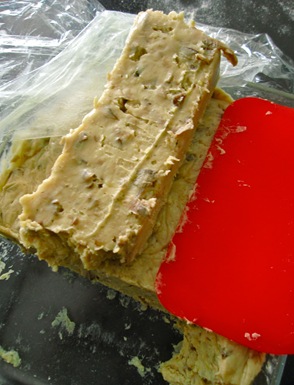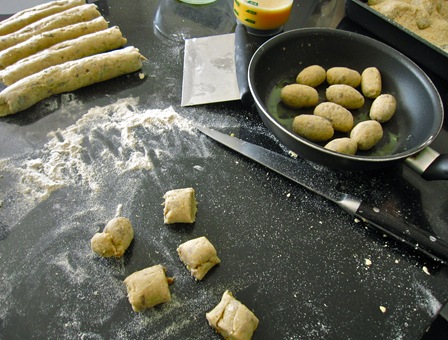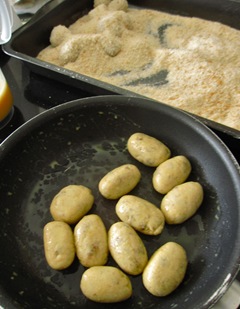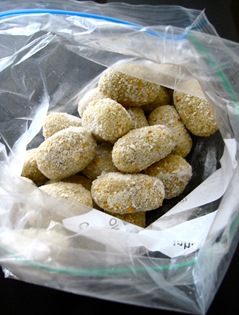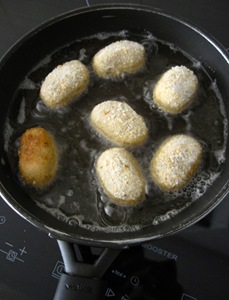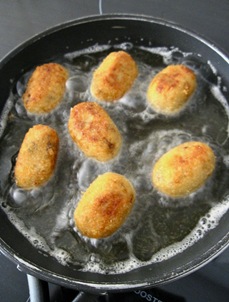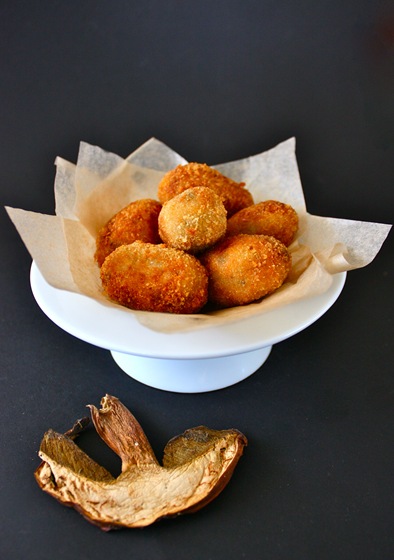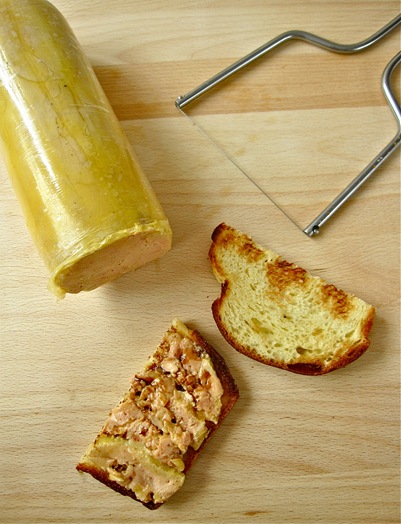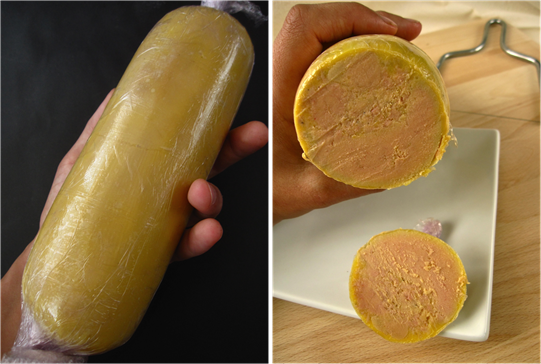Some time ago I watched a series of videos and learnt about the “gavage” (feeding) ducks and geese undergo to obtain the foie gras. From that point on, as much as I liked this highly-valued delicacy, I was determined to not contribute to that and thus to stop buying foie gras in any form for myself. But, since I still have to work with it from time to time, to make it for others or to teach others how to make it, I thought I’d take the fact that I recently had to prepare it for work, to show those who might be interested how to make a proper mi-cuit at home, much better than most you will find ready made.
It may sound contradicting, but the truth is that aside from the fact that for ethical reasons I do not want to make it for myself from over a year back, I’ve learnt to cook using foie since I began working in kitchens. When I started this profession, it was in all the reknown restaurant menus, so I had no choice but to learn how to properly prepare it. And truth be told, I do agree that it is a delicacy, not just for it’s high price, but because if well-prepared it can be delicious; a subtle flavour with a melt in your mouth texture but with a bit of a bite. Though it is a liver, don’t be fooled, it doesn’t resemble a normal (non-gras) liver, not even from a distance. The flavour is completely different, the texture has nothing to do with it…and obviously neither does the price!
But, like I said it is up to you to decide whether to consume it or not…A bit of info on the upbringing of these ducks: The duck used to obtain foie gras is from the “Mulard”variety, and only the males serve this purpose, as the females have too many veins. The ducks go through a healthy upbringing for 3 months (this is the “élevage”). Then, once they have reached maturity, the “gavage” (forced feeding) as such begins (this is the part that disgusts me). It will last about 14 days on which the ducks will be fed about 1kg of corn twice daily to reach the adequate weight.
This forced-feeding will lead to a hypertrophied liver, that is a larger, fatter liver that plays a role in fat storage due to an imbalance between the excessive production of fat and the (in)capacity to eliminate that fat. Though some people have argued the resulting liver is a sick liver,as far as I’ve read, this is not true, as ducks who are removed from the fattening process return within a few days to their normal liver weight, as happens naturally in the wild when migratory birds have depleted their resources after a long journey. BUT, though they are not sick livers, I do believe the animals are in inhumane conditions. Just like hens are in egg farms, but I find this to be worse as it is “gourmet food”, thus not used to feed a population! Type “gavage” on google and you will get to the ugly side of this, I’m sorry I just couldn’t link to it as it tears me to read or watch it.
Just to finish off on what a foie gras is, for the “appelation”, to be considered as such, in ducks, only livers within the 300g-800g range are accepted; on the lower end up to 550g are the “grand cuisine” ones (considered best quality), on the higher end the “restauration” ones. In terms of nutrition, as expected a foie gras is high in fat, though surprisingly most of the fatty acids in it are oleique acid, that which we find in olive oil, rather than saturated fats,as may be expected. So, I wouldn’t make this the reason to avoid foie gras.
After all this, I leave you to what I find the best way to make a mi-cuit terrine (well, in a more convenient cylinder shape!). I hope those of you who like foie gras try it and find that it delivers an extraordinary quality terrine. The starting point, though, is a good quality foie gras!Here’s most of what you need to know…
Duck foie gras mi-cuit
1 duck foie gras (the one I used was about 600g)
13g/kg of salt (I used 8g/600g of foie)
pinch of granulated sugar (I used 1,5g)
freshly milled black pepper
8g of brandy
4g of sherry
8g of port*
*Port is traditionally added to the goose foie gras terrine, whereas armagnac is used for duck ones, but I like adding both!
Many foie gras are found vacuum packed fresh or frozen, so it is difficult to tell the quality. The colour, more yellowish or paler is not necessarily a sign of quality, it simply depends on what the type of corn they’ve been fed on. But, do look for redish stains or bruises, which are not desirable.
If you can check the foie gras fresh, as many french producers sell it, simply wrapped in a sort of parchment paper, look for a foie gras that when pressed though firm, leaves an indentation but that does not feel greasy to the touch, which means it will melt too easily to withhold the slow cooking required to make the terrine without loosing fat.
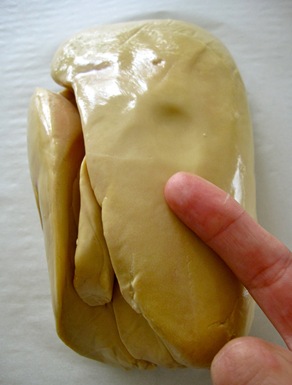
Most chefs recommend immersing the whole foie gras (out of it’s bag, if it comes in one, and already thawed if it was frozen) in salted water at around 35ºC. That is right, but I prefer to use cooler water, from 25ºC-30ºC maximum(specially now in summer, in winter it may be best to raise to the higher end), which results in a malleable foie gras to work with, but with less tendency to get greasy from heating it with your fingers as you work.
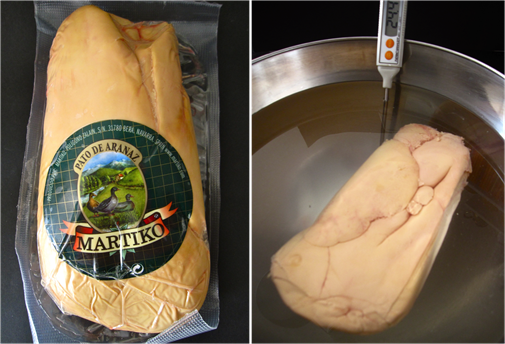
Leave it (covered, it’s a fresh liver after all) for at least 1 hour, until it comes to that temperature and feels softer to the touch. This salted water will draw out impurities and some blood from the veins, as well as temper it.
When ready, remove it from the salted bath and drain it on kitchen paper well. I like to work over a parchment paper to remove the veins on a clean surface and also cause it is really convenient to at the end, just throw away the paper and the veins removed keeping the work surface clean from being in contact with the fatty liver. Hope that convinces you!
The liver consists of two lobes, the large one and the small one, both connected which you’ll need to cut loose to work with each one at a time. The larger one is easier to devein, as the main veins are always located in the same way, whereas the smaller one is just a web of veins difficult to keep track of! So, I always start with the larger one to keep my patience and not demoralize!;)
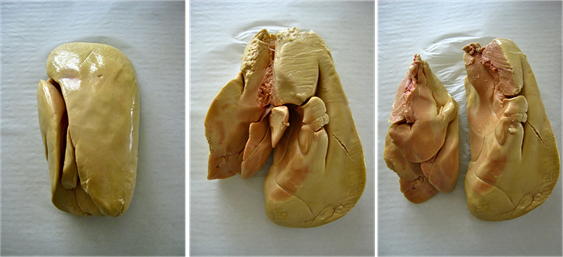
Place the large one thicher side down leaving the smooth side down. The idea with both is to open as much as needed on one side to remove the veins, keeping the other smooth side intact, so that when placed back together, it almost looks as if it’s back to normal!
Use the back of a knife rather than the cutting edge, precisely to avoid cutting the veins and rather just slowly scratch off flesh to expose them and then with your forefinger cleaning it and pull to find the smaller ones that follow from the larger ones.
You will find one vertical large vein running from top to bottom at around 1cm inside the flesh, once you find it, like I said with the back of the knife run it to either side as if you were opening a book to see the smaller connections. Slowly pull with your fingers removing all the smaller ones attached. 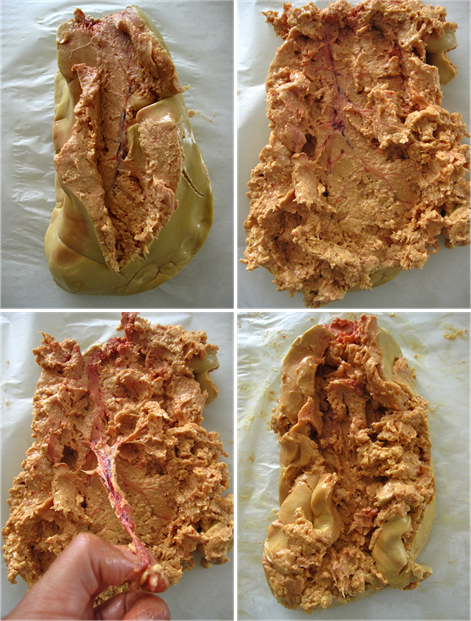
Once that first set is removed, 1cm further down runs the next large vein, repeat the same way. Try to get rid of as many of the smaller veins as possible, as a vein can ruin the texture of a good terrine, it happens way too often!Also try to get rid of the little drops of blood you find, or those will affect the resulting homogeneous colour and may give a bitter taste.
If your hands are hot and you realize it feels like you are literally melting the foie gras, try to immerse them in ice-cold water as you work, drying before touching it, and immersing again as they get warm again.
Funny that my hands used to be soo warm before, so I had to recur to the cooling of my hands; but with time, they have cooled down?!?God knows why?But this trick does it!
Devein the small lobe, though here you must trust your instincts! Go slowly trying to find all veins, just remember to keep the bottom side smooth and whole!
Here are both lobes and the veins removed…
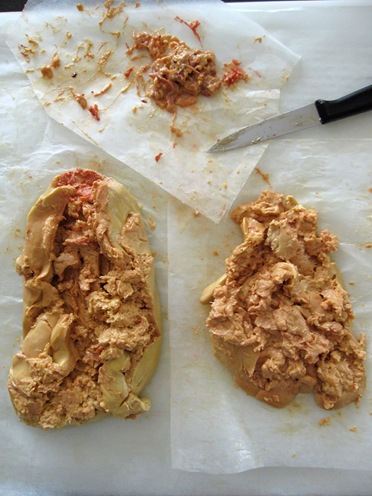
Time to season! I never really measure the amount of salt and sugar, though it is always said 13g/kg is just right. I checked this time and it was about right! It will look like your foie gras surface is saturated with salt, but don’t worry, it is a must if you want it to have a taste, otherwise it will be too bland.

Then, season with a bit of sugar all over the surface (many people don’t add any, but I think it works great for flavour!). Then, pepper, freshly milled if possible! and then a not so light hand with the alcohols :) Well, I’m sort of generous and the amounts I’ve given in the recipe for the 600g foie gras are what I used to taste. Andoni Luis Aduriz, the chef of Mugaritz, who wrote a book on foie gras, recommends: 8cc of armagnac for a 600g foie, 3cc of port and 3cc of dry sherry. As you can see, I’m a bit more generous, specially with the port, I love the notes it brings!!…

Traditionally after seasoning, the foie was covered and left to macerate for 1 day in the fridge. But, I find that if cooked and then given that rest it works really well. So, time to wrap it up…First, notice how when folded back in place, the foie doesn’t look as damaged after all that extensive vein removal!!All the cut sides go inside, so it looks pretty neat again!
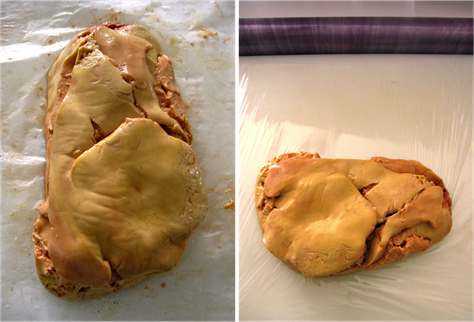
Place it on a cling film leaving the roll, to wrap it up. What we are aiming at now is to remove ALL excess air and press the cylinder tight! You don’t have to shape it as a cylinder, though it is usually done this way and it is quite convenient. In a restaurant I worked at, we kept the foie gras shape intact, just wrapping up in cling film to remove the air and then vacuuming in speacial bags up to about 80%, to avoid squashing of the delicate lobes! If you prefer that shape, keep it, even if you haven’t got a sous-vide machine.
Have a pin or brochette at hand to pick air bubbles as you turn to wrap. Give it as many turns as you need to get a tight cylinder with no air in.
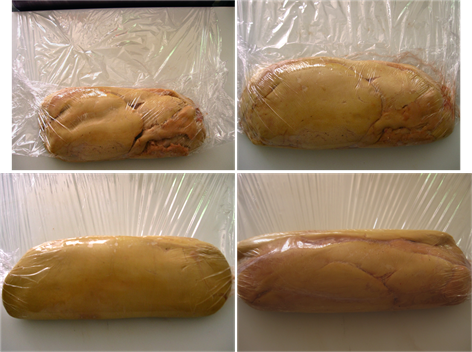
Then, with some twine or cling film threads, cut from the roll (I find this more convenient) secure the sides, rolling to maintain the log tight!
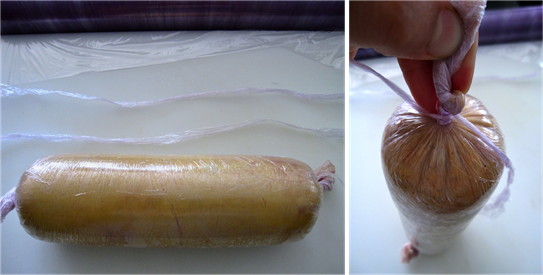
Once rolled, time to cook it. The traditional methods are to either cook it in the oven (at around 70ºC) until the interior temperature is about 45ºC (also, most recipes, advice up to 60ºC), or to do so in a water bath at that temperature, 65-70ºC. But, once I learnt how to use the oven for the mi-cuit, I no longer want to go back to any other method!I was taught to use the oven at high temperature, almost top power for short periods of time, seconds and then, to cool rapidly in iced water.
I’ve slowly shifted onto doing it in a way that I find works best. That is, microwave on very low power, that is from 200-400watts (most microwaves go up to 1000 Watts), sort of like when melting chocolate. This way, the cooking is even, less fat melts and it reaches a perfect, homogeneous cooking, with a fade still slightly pinkish colour. That to me is the best texture, it melts in your mouth and it reaches enough temperature to mingle all those flavours from the seasonings in a very subtle way!
How to tell when it’s ready? By touch! Well, and visually. You should place the foie gras at that power for about 30 second intervals, touch it to test and turn it around for an even cooking. When it’s almost ready for even shorter periods of time. It will be ready when it feels slightly warmer than body temperature and when you see a thin yellowish fat layer forming.
A thin layer, that is, not a thick fat layer as most traditional terrines have…Not that it’s bad, but you just loose too much texture as fat cells burst and melt!So, keep it low (in temperature) until it feels just warmish!Funny that I think I measured how much it was…but I forgot!It’s best to just “feel” it and “see” it, that will tell you best!
Below, though it doesn’t show that well, is the foie gras before going into the microwave, when ready and out and once cooled and set. It will be soft when cooked, it is mainly fat, so like butter at room temperature, it will feel soft until cooled down.
If you can immerse the ready-cooked cylinder into an ice bath…though most of the time, if done right, it can go into the freezer to cool, even if not as fast, to let it continue a bit with the residual heat built up inside. It’s a matter of practice.

You can leave in the freezer, though I think it’s best to leave 1 day in the fridge and then freeze it either whole or into convenient portions that you want to defrost one at a time. Then, just enjoy finely sliced over some toasted bread or brioche (like in the first photo, refer to this brioche recipe, in one word: heavenly!). The truth is that the photo doesn’t make it justice as it was still too soft to handle and added some PX & balsamic reduction (Pedro Ximenez) but took too long to take the photo. But I can assure you it was good…or so did everyone in that cocktail think!
To cut it use a warmed up knife, either with a blowtorch (be careful!though it sounds obvious) or by immersing in some hot water and then dried up before each cut. Or if you have got a wire cheese slicer go ahead!
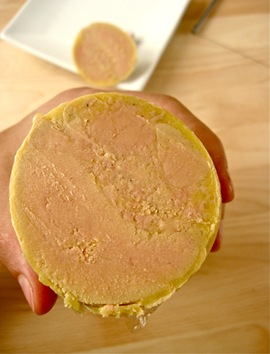
If you decide to try to make your own terrine, I hope this works for you!
Ah, by the way, mi-cuit means half-cooked in french, to differ with a traditional terrine in which the foie gras is usually cooked a bit more. Though, I think it’s terrible to have a mi-cuit underdone, I equally dislike it overcooked. But, if you prefer it, simply cook it for a bit longer until more yellowish fat forms around the cylinder. Bon ap’

